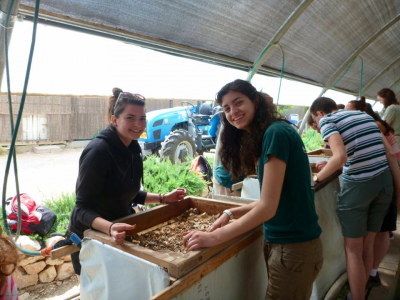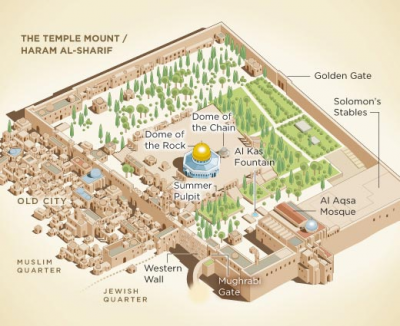In an area near Mt. Scopus which is where we are staying, prominent archaeologist Dr. Gabriel Barkay and his student/colleague Zachi Zweig developed a project for the excavation and sifting of the debris from the Temple Mount.
We’ve kept talking on this trip of how Jerusalem is holy for the three mainstream monotheistic religions of Judaism, Christianity, and Islam. The Temple Mount has no exception to this:
- for Jews, it is the site of the two Temples
- for Christians, this was an important site to crusaders in Medieval times
- for Muslims this is the place of the third holiest mosque (Al-Aqsa) and it is the shrine of the Dome of the Rock
Despite Jerusalem being one of the most excavated sites of the world because of its rich history, the Temple Mount has not seen excavations of the same scale. This is because the Waqf (management of the Temple Mount) has always objected to it
- Construction and renovations were conducted over the last century, digging a hole to make room for a staircase leading into the area known as Solomon’s Stables to turn it into a mosque.
- This resulted in severe damage to ancient remains, about 400 truckloads of which were dumped along the adjacent Kidron valley
Israel actually has antiquity laws which require an excavation before any construction on an archaeological site takes place. In this process, all things pertaining to artifacts are meticulously documented as to their placement and context.
- in the articles this is presented as a complete disregard, as this data can’t be retrieved in the same way
The development of this project started when Zweig was arrested in 2004 by the Israel Antiquities Authority for rummaging around the mound of earth in the Kidron Valley to see if there was anything archaeologically valuable. He was arrested for excavating illegally without a permit.
- even though what was done to the Temple Mount was technically illegal under the antiquity laws
As the name of the project suggests, its purpose is to sift through the debris in the Kidron valley to try and retrieve as many artifacts possible. In order to develop context for these artifacts, a comparative methodology is used which compares them to similar artifacts.
Special techniques were developed for the Temple Mount sifting project; while sifting is common on archaeological sites, because of the special nature of that of the Temple Mount, a wet sifting technique is used. The soil and debris are soaked in water in order to loosen the dirt, following a process of pressurizing hoses through sivving screens.
- this way, bones, coins, and inscriptions can be easily identified
The most frequent finds at the project have been fragments of pottery, glass, metal objects, bones, and worked stones. These are dated from the first Temple period (10th century BCE) onwards. Finds from earlier periods are more scarce
- using the process of wet sifting, a fragment of a 14th century tablet was found: this fragment written in Akkadian is the oldest writing discovered in Jerusalem. No single phrase has been put together from this as it’s so fragmented
More examples of inscriptions discovered at the Temple Mount are sayings of “belonging to…”, telling of people who lived there. There is evidence of a priestly family in the end of the first Temple period, and names mentioned in the book of Jeremiah.
- Finds also include Egyptian scarabs, Israelite seals, many coins from the second temple period and fragments from Herod’s Temple Mount complex
The archaeology from this area is trying to determine details from Solomon’s palace, the city of David–the importance of the city of Jerusalem in the 10th century period.
As the project has expanded over the past decade, special installations were set up to let large groups of volunteers such as ourselves to take part in the wet sifting in Emek Tzurim National Park, where the actual Temple Mount can be seen in the background.
As of last year, more than 130,000 people have taken part in this project. The 20,000 volunteers that visit this site every year share the responsibility of helping with this project since its modest beginnings.


Sources:
“Introduction to the Project.” The Temple Mount Sifting Project. N.p., n.d. Web. 03 May 2014. <http://templemount.wordpress.com/brief-introduction-to-the-project/>
Shanks, Hershel. “Jerusalem Roundup.” Biblical Archaeology Review 37.2 (2011): 35. Web. 3 May 2014.